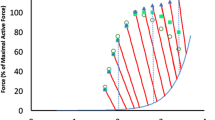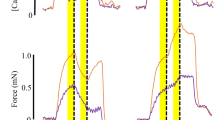Abstract
The isometric force, maximum power and isometric heat rate have been measured at different sarcomere lengths (SL) between 1.40 and 3.63 μm in two types of mouse muscle, soleus and omohyoideus, at 25°C. The SL force relationship is different in the two muscles. At a SL above optimum filament overlap, 2.44 μm in omohyoideus muscles, maximum power declined while isometric force remained high. In soleus muscles this occurred above a SL of 2.33 μm. In parallel experiments, the isometric heat rate declined linearly with increasing SL above 2.33 μm in soleus muscles, while isometric force remained closer to its maximum. At short SL, between 2.33–1.75 μm in soleus and 2.44–2.15 μm in omohyoideus, maximum power remained at or near its maximum value as did heat rate (soleus) while isometric force fell. In both muscles at SL greater than optimum for force development maximum power output (unlike force) is proportional to filament overlap. The variation in heat rate over this SL range can be described as the sum of a constant rate and a rate proportional to filament overlap. These observations are compatible with the idea that maximum power and heat rate are less affected by non-uniformities in SL than is force.
Similar content being viewed by others
References
Abbott BC, Aubert X (1951) Changes of energy in a muscle during very slow stretches. Proc R Soc Lond [Biol] 139:104–117
Bagni MA, Cecchi G, Colomo F, Tesi C (1988) Plateau and descending limb of the sarcomere length-tension relation in short length-clamped segments of frog muscle fibres. J Physiol (Lond) 401:581–595
Bressler BH, Clinch NF (1975) Crossbridges as the major source of compliance in contracting skeletal muscle. Nature 256:221–222
Close R (1972) The relations between sarcomere length and characteristics of isometric twitch contractions of frog sartorius muscle. J Physiol (Lond) 220:745–762
Curtin NA, Woledge RC (1981) Effect of muscle length on energy balance in frog skeletal muscle. J Physiol (Lond) 316:453
Curtin NA, Phillips SK, Woledge RC (1987) An ergometer for isovelocity movement of small, isolated muscles. J Physiol (Lond) 387:3P
Edman KAP (1979) The velocity of unloaded shortening and it's relation to sarcomere length and isometric force in vertebrate muscle fibres. J Physiol (Lond) 291:143–159
Edman KAP, Reggiani CR (1987) The sarcomere length-tension relation determined in short segments of intact muscle fibre of the frog. J Physiol (Lond) 385:709–732
Elzinga G, Peckham M, Woledge RC (1984) The sarcomere length dependence of the rate of heat production during isometric tetanic contraction of frog muscles. J Physiol (Lond) 357:495–504
Granzier HLM, Pollack GH (1990) The descending limb of the force-sarcomere length relation of the frog revisited. J Physiol (Lond) 421:595–615
Hill AV (1953) The mechanics of active muscle. Proc R Soc Lond [Biol] 141:104–117
Hill AV (1965) “Trails and trials in physiology”. Arnold, London
Homsher E, Kean CJ (1978) Skeletal muscle energetics and metabolism. Annu Rev Physiol 40:93–131
Huxley AF (1957) Muscle structure and theories of contraction. Prog Biophys 7:233–318
Huxley AF (1980) “Reflections on Muscle” The Sherrington Lecture XIV. Liverpool University Press, Liverpool
Huxley AF, Peachey LD (1961) The maximum length for contraction in vertebrate striated muscle. J Physiol (Lond) 156:150–165
Jewell BR, Kretzschmar KM, Woledge RC (1967) Length and tension transducers. J Physiol (Lond) 191:10–12P
Julian FJ, Morgan DL (1981) Tension, stiffness, unloaded shortening and potentiation of frog muscle fibres at lengths below optimum. J Physiol (Lond) 319:205–217
McCarter R, Radicke D, Yu BP (1977) A model preparation for studying fast mammalian skeletal muscles. Proc Soc Exp Biol Med 156:40–45
Pollack G (1990) Muscles and molecules: uncovering the principles of biological motion. Ebner, Germany
Rack PMH, Westbury DR (1969) The effects of length and stimulus rate on tension in the isometric cat soleus muscle. J Physiol (Lond) 204:443–460
Rall JA (1982) Energetics of Ca2+ cycling during skeletal muscle contraction. Fed Proc 41:155–160
Rome LC, Morgan DL, Julian FJ (1985) Stimulation rate, potentiators, and sarcomere length-tension relationship of muscle. Am J Physiol C497–502
Simmons R (1991) Moving story. Nature 351:452
Taylor SR (1974) Decreased activation in skeletal muscle fibres at short muscle length. Ciba Found Symp 24:93–115
Traeger L, Goldstein MA (1983) Thin filaments are not of uniform length in rat skeletal muscle. J Cell Biol 96:100–103
Author information
Authors and Affiliations
Rights and permissions
About this article
Cite this article
Phillips, S.K., Woledge, R.C. A comparison of isometric force, maximum power and isometric heat rate as a function of sarcomere length in mouse skeletal muscle. Pflugers Arch. 420, 578–583 (1992). https://doi.org/10.1007/BF00374636
Received:
Revised:
Accepted:
Issue Date:
DOI: https://doi.org/10.1007/BF00374636




